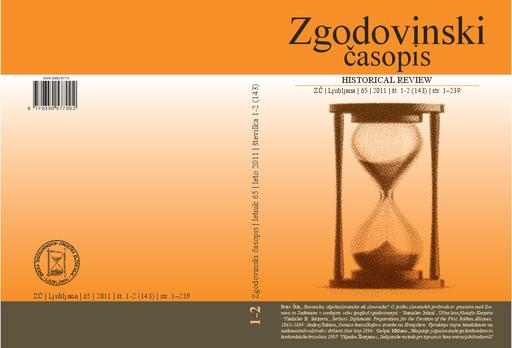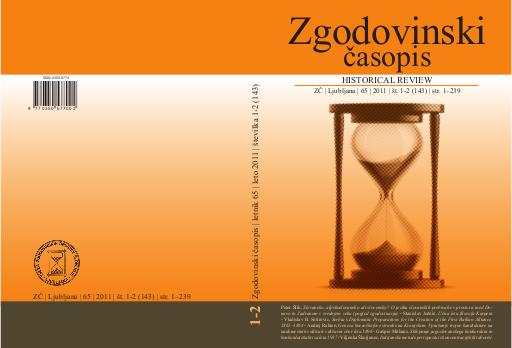/
Serijske publikacije
/
Zgodovinski časopis
Učna leta filozofa Karpeta

Avtor(ji):Stanislav Južnič
Soavtor(ji):Peter Štih (odg. ur.), Dušan Mlacović (ur.), Bojan Balkovec (teh. ur.), Nives Sulič Dular (prev.), Neva Makuc (prev.), Stanislav Južnič (prev.)
Leto:2011
Založnik(i):Zveza zgodovinskih društev Slovenije, Ljubljana
Jezik(i):slovenščina
Vrst(e) gradiva:besedilo
Datoteke (1)

Ime:ZC_2011_1-2.pdf
Velikost:5.59MB
Format:application/pdf
Stalna povezava:https://hdl.handle.net/11686/file18352
Opis
After the introduction of Bošković’s way of Newtonian physics in Ljubljana and Graz the
local professors there were among the greatest promoters of Bošković’s views in their physics and
mathematics lectures. Ljubljana professor Biwald played very important role with his textbooks
of Bošković’s physics after he left Ljubljana for Graz. The Ljubljana professors also promoted
the new ideas in Slovenian lands and even connected them with Asclepi, Bošković’s successor at
Roman College, although Bošković personally disliked him. The future philosopher Karpe was
among the best Pogrietschnig’s Ljubljana students and he used Asclepi’s book for his graduate
work. Karpe was trained in Bošković physics as a young man and kept his sympathy for Bošković’s
world view all his life. Karpe’s connection with Bošković and his followers was the base for his
later criticism of Kant’s philosophy. Bošković was extremely popular among the Mid-European
Jesuits, and his fame did not fade after 1773 when the young Jesuit students Karpe and Jurij Vega
became the professors of their own because they still preferred Bošković’s ideas.
The only Ljubljana Jesuit professor of physics of the strongest Carniolian noble family
Auersperg, Herbert, also supported new Bošković’s ideas and later made an extraordinary success
as Carniolan church official. The development of Ljubljana Jesuit physics and astronomy did not suffer much after the suppression of the Jesuit order because just Jesuit theology professors lost
their positions, but the Jesuits occupied the chairs connected with the mathematical sciences for
next three decades in Ljubljana. The suppression of the Jesuit order obstructed the development
of Bošković’s ideas but in no way removed them from the scientific scene. The Bošković’s followers
were able to develop a strong Mid-European school supporting Bošković which kept its
great influence even in 19th century and paved the way for the modern use of Bošković’s ideas
in quantum mechanics.
Metapodatki (11)
- identifikatorhttps://hdl.handle.net/11686/35009
- naslov
- Učna leta filozofa Karpeta
- Student years of the Philosopher Karpe
- ustvarjalec
- Stanislav Južnič
- soavtor
- Peter Štih (odg. ur.)
- Dušan Mlacović (ur.)
- Bojan Balkovec (teh. ur.)
- Nives Sulič Dular (prev.)
- Neva Makuc (prev.)
- Stanislav Južnič (prev.)
- predmet
- Ljubljana
- jezuiti
- zgodovina filozofije in fizike
- Bošković
- Biwald
- Franc Samuel Karpe
- Pogrietschnig
- Turjačani
- Ljubljana
- Jesuits
- History of Philosophy and Physics
- Bošković
- Biwald
- Franc Samuel Karpe
- Pogrietschnig
- Auerspergs
- opis
- Opisana sta ljubljanski in graški pouk fizike po prevladi Boškovićeve inačice Newtonovega nauka. Izpostavljen je ljubljanski profesor Biwald, ki je po odhodu v Gradec odigral eno vodilnih vlog pri širjenju Boškovićevih naukov. Raziskane so nove ideje v slovenskem prostoru v povezavi s poukom Asclepija, Boškovićevega naslednika na rimskem kolegiju. Med najbolj blestečimi študenti ljubljanskega profesorja Pogrietschniga je bil poznejši kritik Kantovega nauka, Karpe. Edini jezuitski profesor fizike iz vrst najmočnejše kranjske družine Turjačanov, Herbert, je prav tako podpiral nove Boškovićeve ideje med jezuiti in pozneje napredoval v enega najvišjih kranjskih cerkvenih dostojanstvenikov. Razcvet ljubljanske jezuitske fizike in astronomije je spodkopala prepoved jezuitskega reda leta 1773, po kateri so jezuiti resda izgubili bogoslovne katedre, ne pa tistih, povezanih z matematičnimi vedami.
- The physics lectures after the introduction of Bošković’s way of Newtonian physics in Ljubljana and Graz was described. Ljubljana professor Biwald played very important role at the introduction of Bošković’s physics after he left for Graz. The new ideas in Slovenian lands were connected with Asclepi, Bošković’s successor at Roman College. The philosopher Karpe was among the best Pogrietschnig’s Ljubljana students. The only Jesuit professor of physics of the strongest Carniolian noble family Auersperg, Herbert, also supported new ideas and later made an extraordinary success as Carniolan church official. The development of Ljubljana Jesuit physics and astronomy did not suffer much after the suppression of the Jesuit order because just Jesuit theology professors lost their positions, but the chairs connected with the mathematical sciences were occupied by Jesuits for next three decades.
- After the introduction of Bošković’s way of Newtonian physics in Ljubljana and Graz the local professors there were among the greatest promoters of Bošković’s views in their physics and mathematics lectures. Ljubljana professor Biwald played very important role with his textbooks of Bošković’s physics after he left Ljubljana for Graz. The Ljubljana professors also promoted the new ideas in Slovenian lands and even connected them with Asclepi, Bošković’s successor at Roman College, although Bošković personally disliked him. The future philosopher Karpe was among the best Pogrietschnig’s Ljubljana students and he used Asclepi’s book for his graduate work. Karpe was trained in Bošković physics as a young man and kept his sympathy for Bošković’s world view all his life. Karpe’s connection with Bošković and his followers was the base for his later criticism of Kant’s philosophy. Bošković was extremely popular among the Mid-European Jesuits, and his fame did not fade after 1773 when the young Jesuit students Karpe and Jurij Vega became the professors of their own because they still preferred Bošković’s ideas. The only Ljubljana Jesuit professor of physics of the strongest Carniolian noble family Auersperg, Herbert, also supported new Bošković’s ideas and later made an extraordinary success as Carniolan church official. The development of Ljubljana Jesuit physics and astronomy did not suffer much after the suppression of the Jesuit order because just Jesuit theology professors lost their positions, but the Jesuits occupied the chairs connected with the mathematical sciences for next three decades in Ljubljana. The suppression of the Jesuit order obstructed the development of Bošković’s ideas but in no way removed them from the scientific scene. The Bošković’s followers were able to develop a strong Mid-European school supporting Bošković which kept its great influence even in 19th century and paved the way for the modern use of Bošković’s ideas in quantum mechanics.
- založnik
- Zveza zgodovinskih društev Slovenije
- datum
- 2011
- tip
- besedilo
- jezik
- Slovenščina
- jeDelOd
